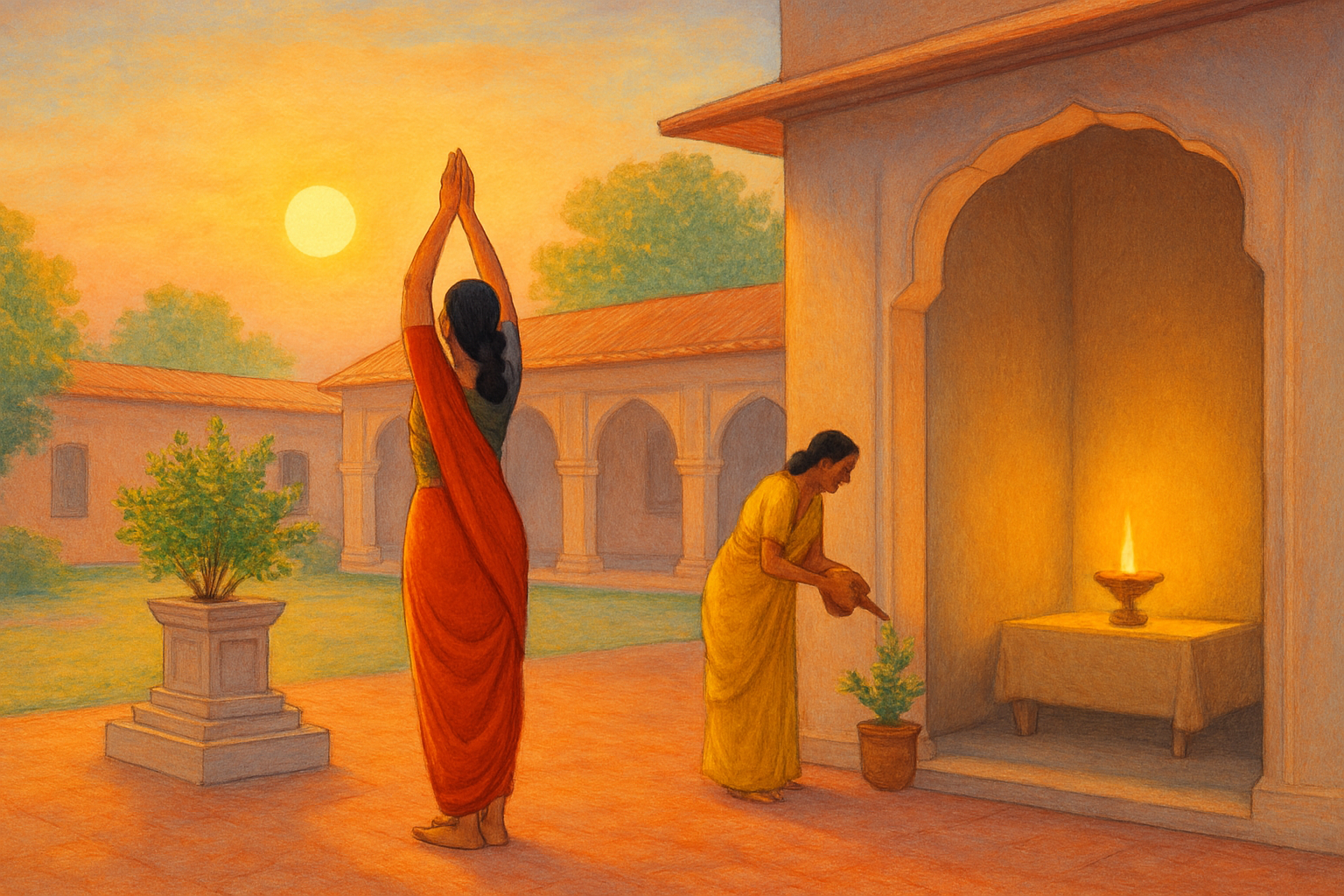
What Is Daily Dharma in Sanatan Life?
In the timeless tradition of Sanatan Dharma—the eternal way—Dharma is more than just a religious concept. It is a way of living rooted in universal values, spiritual discipline, and alignment with cosmic truth. But while dharma may sound philosophical, its most powerful expression is often in the simplest, daily actions.
This is what we call “Daily Dharma”—a sacred rhythm of life practiced through small yet profound rituals, intentions, and duties that align the mind, body, and soul with the divine.
Let’s explore what Daily Dharma really means and how it weaves itself into the life of a Sanatani.
What Is Dharma?
The word “Dharma” in Sanskrit is derived from the root “dhri,” meaning to uphold or sustain. It refers to the natural order of things, moral responsibility, and spiritual duty.
In Sanatan Dharma, each individual has a dharma based on their stage in life (ashrama), nature (guna), and role in society (varna). But there are also universal dharmas that apply to all: truthfulness, non-violence, compassion, self-discipline, and respect for all life.
Daily Dharma is the practical application of these values in our everyday existence.
Why Is Daily Dharma Important?
In today’s fast-paced world, spiritual practices are often limited to festival days or moments of crisis. But Dharma is not meant to be occasional. It’s a daily practice, designed to:
-
Create inner harmony
-
Foster discipline and mindfulness
-
Align us with the cosmic order
-
Connect us with our higher self
Just as the sun rises and sets each day without fail, so too is the Sanatani life built on consistency and reverence through daily acts of dharma.
Foundations of Daily Dharma in Sanatan Life
Daily Dharma includes a variety of spiritual and ethical practices. Here's how it unfolds throughout the day:
1. Early Rising (Brahma Muhurta)
Waking up before sunrise (around 4–6 AM) is considered spiritually powerful. This time is known as Brahma Muhurta, when the mind is calm and the atmosphere is charged with sattva (purity).
"He who rises in Brahma Muhurta lives long and healthy," says the Ayurveda.
2. Cleansing and Purification
After waking, physical purification (snana or bath) is followed by mental and spiritual purification. Many chant mantras or silently express gratitude. Some also sip water (achamana) with sacred names of Vishnu for inner cleansing.
3. Sandhyavandanam (Daily Prayer)
Performed at sunrise, noon, and sunset, Sandhyavandanam includes Gayatri Mantra chanting, offering water to Surya (sun god), and silent meditation. It connects the practitioner with the cycle of nature and promotes mindfulness.
4. Puja and Devotion
A simple puja (ritual worship) to one’s chosen deity, lighting a lamp (deepa), offering flowers, and chanting slokas forms the heart of daily worship. It’s not about grandeur but bhava—the feeling of devotion.
For householders, the kitchen becomes a temple, and food is first offered to God (naivedya) before consumption.
5. Karma Yoga (Selfless Duty)
Doing one’s duties at work, home, or society with a selfless attitude is also part of Dharma. This is called Karma Yoga—working not just for personal gain, but as an offering to the divine.
Whether one is a teacher, farmer, artist, or student, doing one’s job with integrity and dedication is itself a spiritual practice.
6. Svadhyaya (Self-study)
Daily Dharma includes reading scriptures, such as the Bhagavad Gita, Upanishads, or Ramayana. Even 10 minutes of sacred reading helps anchor the mind in higher wisdom and purpose.
It also includes reflection—asking, “Was I kind today? Was I truthful? Did I help others?”
7. Ahimsa and Mindful Living
Non-violence (ahimsa) extends to thoughts, speech, and actions. It means speaking truthfully but kindly, treating animals with compassion, avoiding waste, and living in harmony with nature.
This is why many followers adopt vegetarianism, use sustainable products, and avoid excessive consumption.
8. Evening Practices and Silence
As the sun sets, another Sandhya (transition) takes place. Lighting a lamp at dusk, chanting mantras, and sitting in silence allows the mind to wind down and reflect.
Some families chant Rama Raksha Stotra, Vishnu Sahasranama, or Mahamrityunjaya Mantra in the evening.
Dharma for Every Role and Stage
Daily Dharma is not one-size-fits-all. Sanatan Dharma recognizes:
-
Brahmacharya (student) stage – Focus on learning and discipline
-
Grihastha (householder) stage – Focus on family, service, and devotion
-
Vanaprastha (retired) stage – Focus on detachment and deeper study
-
Sannyasa (renunciate) stage – Focus on total surrender and moksha
Dharma is adapted to your stage in life. What remains constant is intentional, conscious living.
Modern Relevance of Daily Dharma
Even if you live in a city, work long hours, or don’t follow rituals strictly, you can still live your dharma. Here’s how:
-
Wake up early and express gratitude
-
Light a lamp and chant a simple mantra
-
Do your work with honesty and care
-
Be kind to all beings
-
Eat with awareness and offer food mentally to God
-
End the day with reflection or a short prayer
Daily Dharma is about connection—not perfection.
Conclusion: Dharma Is the Path to Peace
In Sanatan life, Dharma is not a burden—it is a guidepost, helping us walk through joy and sorrow, success and failure, with grace. It doesn’t demand complex rituals but simple, conscious living rooted in love, service, and spiritual awareness.
Living Daily Dharma transforms ordinary routines into acts of worship, and daily duties into a divine offering.
That is the Sanatan way—eternal, natural, and always sacred.
"Dharmo Rakshati Rakshitah" – Dharma protects those who protect it.
